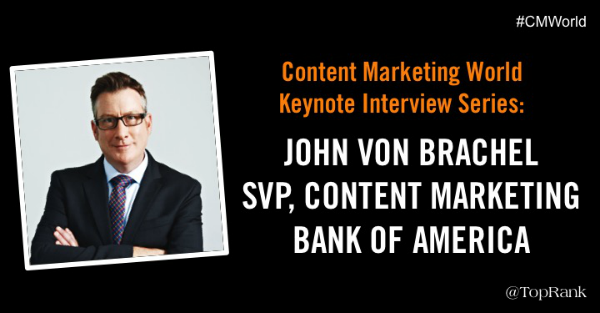One of the most valuable resources for just about any company is the talent, expertise and insight from internal experts and executives, especially when it comes to content marketing. However, understanding the best practices and putting them into action within a large, complex organization is another thing entirely.
That’s why we are fortunate to hear from Content Marketing World 2016 keynote speaker John von Brachel. John has a deep editorial background at companies ranging from Time Inc. to Merrill Lynch to his current role as SVP and Content Marketing Executive at Bank of America. These roles have positioned him with very unique insight into the role of content marketing at the enterprise level.
In this interview, John talks about his editorial background, how he stays current, motivating executive participation with content and a preview of his keynote and breakout session presentations at CMWorld.
As Senior Vice President, Content Marketing Executive at Bank of America, what role does content marketing play in your responsibilities?
I manage the content marketing center of excellence within Bank of America. The content marketing center of excellence was created to help Bank of America better deliver education and insights to the audiences we care most about. That means being more efficient at creating higher quality content experiences.
“My job is to connect our content marketing teams so we can work together more seamlessly and effectively.”
For instance, my job is to connect our content marketing teams so we can work together more seamlessly and effectively, whether it’s through processes that help with collaboration, or new technology platforms that make our work more accessible and transparent.
What is great about the bank is that we have so many people who are considered experts in the investor relations industries—people want to hear their stories and what they have to say. To help make that happen, we work to package their reports and thought leadership in creative ways that makes it easy and compelling for people to access when and where they want it and, ultimately, share that content with others.
How has your editorial background best helped to prepare you for your roles in managing content marketing programs?
“Good content marketers need to have both left-brain and right-brain skills.”
I believe good content marketers need to have both left –brain and right-brain skills. It is especially important to be able to identify higher-quality content and to provide strong direction to both your internal teams and your agency partners. In fact, helping your partners and teams create great content starts with the clear and confident direction you give them. My editorial background has given me the perspective to recognize what great content looks like.
Information overload applies to content marketing advice as much as it does to consumers. What kinds of information sources do you rely on to stay sharp, current and on top of content marketing best practices?
I try to connect with peers as much as possible in and outside of the industry for best practices. I also rely heavily on agencies to inform me on what they’re seeing. I read a lot of trade publications and blogs like yours. And, of course, I attend conferences like Content Marketing World, which offers a great opportunity to connect with talented people and talk about where they see the proverbial puck is going in the content marketing industry.
I’m also a social media wonk – mostly because it helps me stay connected with my two daughters. It is important for me to know how to connect with them — I learn a ton from that.
“Learning is all about having a sense of humility – be open minded and assume there are others who know more than you.”
But to be honest, I think that learning is all about having a sense of humility – be open minded and assume there are others who know more than you. Then it’s your job to find and connect with them. That’s how I try to stay ahead.
Considering your work on ensuring internal thought leaders inform content programs, what advice do you have for other marketing executives that want to collaborate with executives more on brand content initiatives?
I’d tell them that it’s their job to socialize the value of what they’re doing and offering. I am often in meetings with the sole purpose of talking about how content marketing adds value to our business, employees and customers. And do it with empathy — these executives have a ton on their minds and their plates. Go into these meetings with the goal of solving their problems. Empathy matters.
What do you think are some of the fundamental obstacles companies face when trying to execute an integrated content marketing strategy? What are some possible solutions to those challenges?
“A compelling and consistent story allows you to build better relationships with your audiences.”
They have to have volition to create a strong strategy and to truly connect their teams and agencies teams. It takes work and resources to do this. The benefits are clear—you have a compelling and consistent story to tell, one that allows you to build better relationships with your audiences.
You can also do more to sequence these stories to your audiences in ways that keep them connected to you and your brand over longer periods of time. They are coming back to you because they value your stories and the innovative ways you are delivering them.
At this year’s Content Marketing World you are giving a keynote presentation, “Take Notice: What it Takes to Inspire Audiences and Distinguish Your Brand”. What can attendees look forward to most from this presentation?
This presentation will focus on what it means to understand your audience and to understand a new form of storytelling. I will also talk about the importance of differentiation your company through higher-quality content –and what that means as content quality evolves and changes.
You are also presenting, “How to Build an Audience-First Approach to Content Marketing”. Care to share a few of the most important takeaways?
In this presentation I will focus on contextual relevance; what it means and why is it important. In a world where people are looking for personalized information in context, every day, it’s important for brands to be contextually relevant. I’ll share my perspectives on how to do that.
What are you looking forward to most at this year’s Content Marketing World conference?
I’m looking forward to learning from the smart people who are there, and networking between the sessions. I am always looking for top talent, people who are doing great things with content marketing. I will attend sessions as well, looking for great ideas I can borrow or apply.
Any predictions about what the state of content marketing will be by 2020? Will it have something to do with Pokemon Go or VR?
Absolutely. Those are two good examples of audience based connection – being where and how people want to consume content.
“More companies will work directly with distinguished media brands to help tell their story.”
But it’s not just about the technology or the platform. I think you’ll see more and more companies looking to work directly with distinguished media brands to help tell their story.
Basically, it will likely move from creating a ton on your own to curating via closer media partnerships. Companies who stay close to these media companies and their audiences can go along on the ride with them. And think differently about the definition of ‘media giant.’
For example, General Electric (GE) took over Lena Dunham’s newsletter to honor women in science. That kind of partnership could happen between companies and other brandividuals as well.
Now let’s play a little social network word association. After each platform, share the first word or short reaction that comes to mind.
- Facebook – Reach
- Vine – Concise
- LinkedIn – Career
- Periscope – Voyeur
- Twitter – Connected
- Google+ – Option
- Snapchat – Ethereal
- YouTube – Must-see TV
- Instagram – Moments
- Flickr – Archives
John von Brachel is Senior Vice President, Content Marketing Executive at Bank of America.
John leads content integration for Bank of America Global Wealth and Investment Management businesses, as well as Content Marketing for Merrill Lynch Wealth Management. Prior to joining Bank of America, John was Group Managing Editor at Time Inc. Content Solutions. John joined Time Inc. from Individual Investor magazine where, as senior editor, he covered equity investing. John has also served in Germany as the Foreign Correspondent for Faulkner and Gray. He earned his B.A. at Virginia Commonwealth University, and a Masters in Science from New York University.
You can connect with John on Twitter: @vonbrachel
If you would like the opportunity to learn more about an audience focused approach to content marketing as well as anything and everything else to do with content marketing, then Content Marketing World Sept 6-9 is a must attend event. There you can learn from any of over 150 industry experts in a variety of presentations and workshops on everything from strategy and planning to content and media creation to measurement and optimizing ROI.
You can also network with a group of over 4,000 attendees from companies of all sizes. I’ve been to every CMWorld conference and it is a great networking and learning opportunity!
In case you missed one, here is a list of Content Marketing World 2016 keynote speaker interviews we’ve published:
- Stephanie Losee, Head of Content at Visa
- Kathy Sterio, GM Product & Marketing at General Electric
- John van Brachel, SVP, Content Marketing Executive at Bank of America




